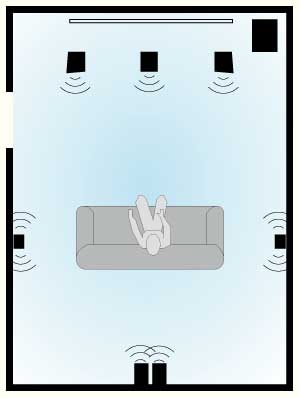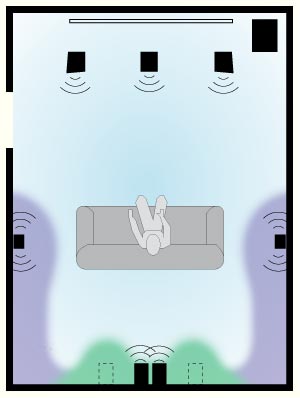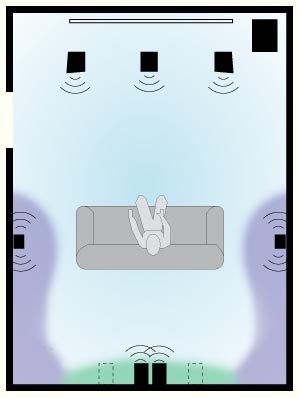Subwoofers
THX-Certified subwoofers embody the usual tenets of bass,
which is both high in output and low in distortion. Back to Reference
Level, a THX subwoofer has to be able to reproduce the bass from all the
channels of a
sound track at Reference Level (within a room size limitation) without
distress or calling undue attention to itself. Beyond that, like
regular power amplifiers, the built-in amplifiers of THX subwoofers must conform to an I/O spec
that matches the THX controller. In particular, voltage levels are
much higher than for the other line-level signals, several times higher in
fact! This gives the subwoofer the 20 dB headroom it needs over any
other channel (because it carries the bass from all channels, plus the LFE
channel, all summed together).
In terms of depth, THX subwoofers are traditionally
anechoically flat to 35 Hz with a shallow roll-off thereafter, allowing
room-gain to make up the difference for a perceived flat in-room response.
That has changed somewhat with Ultra2, which we'll get to in a moment.
Projection Screens and Other Things
THX also has a specification and certification for
perforated, acoustically transparent screens, which obviously involves
ensuring they really are acoustically transparent, or at least that the loss
incurred is predictable and uniform such that it can be easily compensated
for. Light loss must also be minimized.
Although of little
interest now, THX at one time had certification of LaserDisc players.
Rane and AudioControl had THX-Certified equalizers, which
are still prized pieces.
THX Select vs. Ultra
In 1999, THX launched THX Select, and renamed what had
previously been called just THX to THX Ultra.
Whereas THX/THX Ultra was specified and designed for rooms
"up to" 3000 ft3, THX Select took that requirement down to 2000
ft3.
Both the requirements of the amplification and the output of the speakers were
scaled back appropriately, placing THX in the hands of a whole new audience
who could not have otherwise afforded it.
When it comes to amplification, continuous output tests are run on
up to one, four, and five channels (simultaneously) of an Ultra product, but only one at a time on Select.
With all products, the dynamic amplifier tests are done on up to all available channels. Ultra amplifiers must be stable on all channels to
3.2 ohms and swing an 18A peak, while Select products must be stable into 4 ohms
(front channel) and 8 ohms (surrounds), and swing peaks of 12.5A and 6.2A
respectively.
So, right off the bat, Select amplifiers have a lower bar to reach,
but ultimately in meeting it, they will still cleanly drive any reasonably
designed speaker to reference level in a Select-size room. What we are
talking about here is the idea that the lower powered equipment can get a
THX certification that will assure consumers that the really affordable
stuff has met certain standards like the high-end equipment.
The THX Controller section features are no different between
Select and Ultra, which is why you'll never see a Select preamp/processor (SSP),
only Select Receivers.
THX Select speakers, other than having reduced output
requirements as compared to Ultra, do not have the same requirement for a
narrow vertical listening window, because in a Select-size room you are apt
to be close to the speakers and floor/ceiling reflections are that much less
of an issue. While THX Select surround speakers are still recommended
to be dipole in design, conventional monopole designs are permitted
for a few reasons, the main being that dipoles are, by their nature,
expensive (having twice as many drivers as a conventional monopole), which
goes against Select's mandate for a more affordable system.
Select subwoofers of course have reduced output requirements
as compared to Ultra.
Ultra 2: The Second Age
In 2001 THX revamped their Ultra program into Ultra2.
Ultra 2 Processing
One of the catalysts of the revamp was the enthusiastic consumer embrace of
THX Surround EX and the 7.1 speaker layout that it implies, but Surround EX decoding only "works" well if the sound track
was implicitly encoded for it, otherwise the surround sound filed tends to
collapse to the center surrounds. At the same time, multi-channel music
was becoming more of a presence in the market, and speaker arrangements for
music vs. movies were at odds with each other, with movies favoring a very
diffuse sound field produced from the sides, and music favoring more
in-your-face surround, with the source being more "behind" you.
With Ultra2, THX came up with a single system and speaker
configuration which would work for everything.
Whereas THX Surround EX simply called for two more
surround speakers at the back of the room for the then new sixth channel,
Ultra2 replaced them with a pair of monopole speakers specifically placed right next to each other.
Somewhat like the way
two-channel stereo can "position" sounds between two speakers,
THX with their new process they call ASA, or Advanced Speaker
Array, is able
to "position" virtual surround speakers between the side surround speaker
and the corresponding rear speaker (it's not really that simple, but it
is the best way to visualize it). So while Ultra2 controllers still
offer THX Cinema and THX Surround EX modes, THX introduced
three new THX modes with Ultra2 which use ASA:
THX Ultra2 Cinema. This mode is identical to
THX Cinema, except it does a "soft EX decoding", giving us some output from
the rear, but does not allow the sound to collapse there. Surround
sound predominantly comes from the side dipole speakers.
THX Music. This mode differs from the above in
two ways. First, using ASA, the surrounds are virtually positioned
between the side and corresponding rear speaker, a position usually favored
by multi-channel music setups. This mode also disengages Re-Eq because
music tends to be enjoyed at a lower median level than movies, and as such
does not need it.
THX Game. This mode basically puts all surround
speakers on full duty, giving you a very lively, "exciting" sound
experience which is what people want when playing an active video game.
|
 |
 |
| The THX Ultra2 Layout |
For THX Surround EX, ASA
places "virtual" speakers in the requisite position. |
|
 |
 |
| For Ultra2
Cinema, ASA "softens" the rear channel, keeping it active, while
eliminating the "collapse" associated with Surround EX decoding of
non-EX encoded material. |
For Ultra2
Music, ASA places "virtual" speakers in the location favored by
multi-channel music enthusiasts, while maintaining an overall spacious
surround space. |
Its important to note that the Ultra2 controller has a
setting for the distance between the two rear speakers, the default being
<1ft as depicted above, yielding the most spacious sound field. The
alternate setting of 1-4 ft can be used to "favor" the music playback mode.
By moving the physical rear speakers apart, there is less of a "virtual
speaker", with more of the surround sound in Music mode coming from the
monopole rear speakers.
Click Here
to Go to Part V.